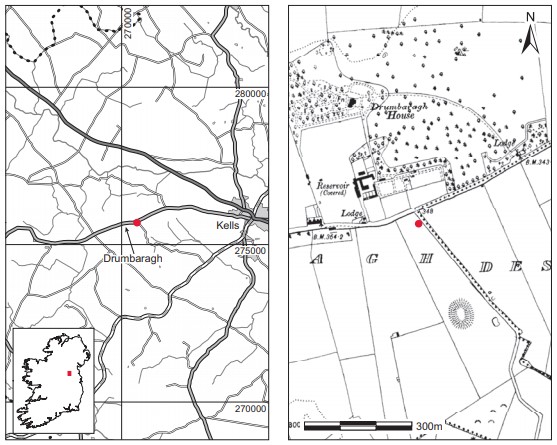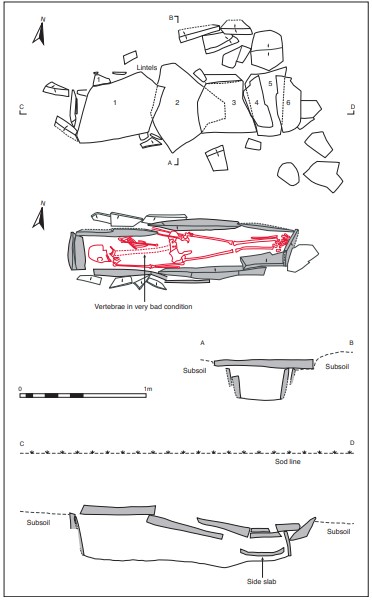County: Meath Site name: DRUMBARAGH, CO. MEATH
Sites and Monuments Record No.: SMR ME016-060SMR ME016-022 Licence number: E1134
Author: MARY CAHILL
Site type: Iron Age and early medieval graves, c. 300 BCc. AD 1200
Period/Dating: —
ITM: E 670429m, N 775718m
Latitude, Longitude (decimal degrees): 53.726368, -6.932755
Introduction
In October 1998, during the removal of topsoil for a new driveway, a lintel grave containing an inhumation was discovered near Kells, Co. Meath. The site was reported to the NMI by Garda Síochána at Kells, and a rescue excavation was undertaken by Mary Cahill and Niall Brady. The human remains from the site were analysed by Barra Ó Donnabháin.

Location (Fig. 4.38)
The site was in the townland of Drumbaragh in west County Meath, close to the border with County Westmeath.82 It was approximately 3km west of Kells on the south side of the road between Kells and Crossakeel at an altitude of 100–110m above sea level. The SMR lists a ringfort approximately 40m south of the site and a holy well 1.5km to the north-west.83
Description of site
The cist was roughly rectangular in plan, with its long axis aligned east/west. It measured 1.7m long internally by 0.5m wide (Fig. 4.39). The cist walls were formed of thin slabs set on edge, three at the south side and three at the north. A second row of slabs had been placed outside the northern wall near the western end, probably to support the inner row of slabs at this point. A number of packing stones were also visible outside the southern wall of the cist at a lower level than the side stones. The western end of the cist was closed with two slabs, one parallel to the other, and the corner was supported by a number of small packing stones. The eastern end was closed with a single slab, which appears to have split vertically down the centre. A smaller slab noticed outside this may have been placed to support it. A number of edge-set slabs were noticed approximately 0.3m north of the cist, lying on almost the same axis. Their precise relationship with the cist is not known, but they may have served as some sort of support for the side stones. The cist was covered with six lintels, which overlapped slightly. The easternmost lintel was covered by a second smaller slab.
The grave contained an extended inhumation of a young adult female (1988:189) and no accompanying artefacts were found. The burial lay in a supine position, with the head to the west and the feet to the east. The skeleton fitted tightly into the cist, with the arms by the sides and the feet close together. A sample of the human remains was submitted for radiocarbon dating and yielded a date of 1465±45 BP, which calibrates to 442–659.84
Comment
It is possible that this burial was not a single occurrence, but no associated graves were found at the time of discovery. The burial may have been associated with the ringfort that was situated less than 50m away.
HUMAN REMAINS
BARRA Ó DONNABHÁIN
Introduction
The remains (1988:189) are those of one individual and are in a reasonable state of preservation. Some cortical bone has been lost from many elements and portions of some bones have disintegrated completely. Despite this, the skull and at least parts of all long bones were recovered. Some of the bones of the hands and feet as well as at least five ribs are also present. From the spinal column, only the first two cervical, fifth lumbar and first two sacral elements were recovered.
Age and sex
This individual was a female. This was indicated by the shape of the greater sciatic notch and the presence of a preauricular sulcus, as well as the gracility of the mastoid processes, nuchal crest and supraorbital ridges. The state of fusion of the endocranial sutures and the retention of epiphyseal lines indicate that this was probably a younger adult.

Fig. 4.39—Plans and sections of grave, Drumbaragh, Co. Meath.
Teeth
All of the teeth were present and fully erupted at the time of death, although the following teeth were lost post-mortem:

There are deposits of dental calculus on all teeth. These are heaviest on the lingual aspect of the mandibular dentition, where the deposit could be classified as moderate.
Molar wear is slight, with only enamel polishing occurring on all second and third molars. First molars have very small facets of dentine exposed.
Relatively large pits occur on the occlusal surface of each of the third molars. These defects had become carious in all but the upper right third molar.
Linear enamel hypoplasia occurs on the upper central and lateral incisors, as well as the upper right second premolar. These defects are usually caused by some systemic disturbance such as malnutrition or an infectious disease. In this instance, the causative disturbance(s) occurred between the second and sixth years of life.
Pathology and anomalies
No pathological conditions were observed in the remains. This may be a reflection of the fragmentary nature of the remains.
Stature
Standard formulae developed for obtaining the stature of European females from dry bone produced a living stature estimate of c. 160cm for this individual.
82. Parish of Kells, barony of Upper Kells. SMR ME016-060——. IGR 270494 275701.
83. SMR ME016-022---- and ME016-051---- respectively.
84. GrA-24502.